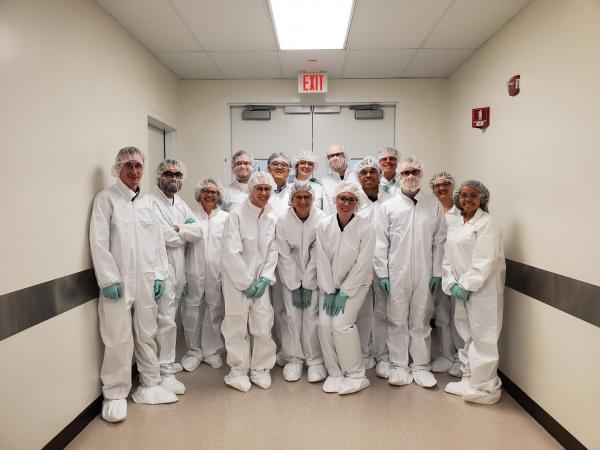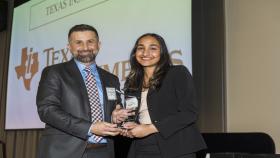A group of 12 trainees from the Georgia Institute of Technology, and a few other institutions, were treated to a close-up look at inner workings of a global biopharmaceutical company in late April with an extended tour of Celgene’s manufacturing facility in Summit, New Jersey. The trainees, from the NIH Cell and Tissue Engineering Training Program (CTEng) and the NSF Engineering Research Center for Cell Manufacturing Technologies (CMaT), gained a deeper understanding of how a large drug manufacturer works and the potential career paths waiting for them in the industry sector.
“It was interesting to see how much money goes into scaling up a product for large-scale use, and how important it is to be able to scale up a product prior to attempting to commercialize it,” noted Kalina Paunovska, a bioengineering Ph.D. student who works in the lab of James Dahlman, Petit Institute researcher and assistant professor in the Wallace H. Coulter Department of Biomedical Engineering (BME).
“The company made a great point that it does not matter how good the product is if it can’t be manufactured at a scale where it can be distributed to a large number of people,” she added.
For most of the trainees, like Ph.D. student Juan Medina from the lab of Petit Institute Executive Director Andrés García, this was a first-time opportunity to visit a cell manufacturing facility.
“I was impressed by Celgene’s foresight, as it has enabled them to scale up their cell therapies while still working on their trials,” Medina said. “Prior to the visit I did not know that individual roles were so specific throughout the pipeline process. I quickly realized that this is set up in such a way to optimize efficiency. The visit was helpful in providing me with an idea of what work is like in a large industrial setting. Coupled with a tour I took of a much smaller company earlier this semester, our visit to Celgene made me realize how broadly applicable and valuable the skills developed during a Ph.D. can be.”
For Ph.D. students in the realm of cell therapy, it was a valuable experience. But it also paid off for trainees outside of the discipline.
“I don’t work in the cell therapy space, but I do appreciate the novelty and impact that these new techniques have,” said Andrew Raddatz, a BME Ph.D. student in the lab of Melissa Kemp, Petit Institute researcher and BME associate professor. “Being able to tour both the research and commercial space of Celgene was incredibly informative. Seeing that the research and development space was like a typical cell culture lab you might see on Georgia Tech’s campus made these employee positions more relatable.”
The trainees spent most of their visit touring Celgene’s analytics development section and process development section, noted Raddatz, who also added, “Being able to see people working in the commercial facility with more routine jobs of developing the CAR T cells, patient by patient, was also helpful. These people are saving lives in a heavily regulated area which carries a lot of stress along with it, so their diligence is not only impressive but necessary. The fact that CAR T manufacture cannot be scaled up, only scaled out, makes each dose a very finely monitored product. Overall, this trip highlighted the importance of the industry and how, in an ideal world, companies can find ways to maximize production, reduce costs, and help the most people possible.”
In addition to Paunovska, Medina, and Raddatz (all based at Georgia Tech), the other participating trainees were, from Georgia Tech, Meghan O’Melia, Shannon Anderson, Alex Beach, Brian Liu, Nico Villa-Roel, and Thomas Turners. From the University of Georgia it was Emily Pendleton. Rocio Arroyo from the University of Puerto Rico and Aaron Simmons from the University of Wisconsin rounded out the group.
Media Contact
Jerry Grillo
Communications Officer II
Parker H. Petit Institute for
Bioengineering and Bioscience
Keywords
Latest BME News
Jo honored for his impact on science and mentorship
The department rises to the top in biomedical engineering programs for undergraduate education.
Commercialization program in Coulter BME announces project teams who will receive support to get their research to market.
Courses in the Wallace H. Coulter Department of Biomedical Engineering are being reformatted to incorporate AI and machine learning so students are prepared for a data-driven biotech sector.
Influenced by her mother's journey in engineering, Sriya Surapaneni hopes to inspire other young women in the field.
Coulter BME Professor Earns Tenure, Eyes Future of Innovation in Health and Medicine
The grant will fund the development of cutting-edge technology that could detect colorectal cancer through a simple breath test
The surgical support device landed Coulter BME its 4th consecutive win for the College of Engineering competition.








